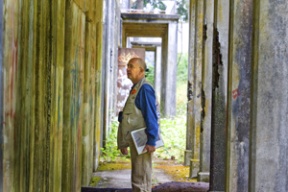Historians oppose plans to build on a century-old gun emplacement.
The mortal wound came in early autumn, 1777, at the hands of British troops. Soon after, Brigadier General Francis Nash was laid to rest in Pennsylvania dirt.
But some 125 years later, on a breezy hillside at Fort Ward at the turn of the 20th century, Nash’s guns began playing peekaboo with Puget Sound.
They rose and fell stealthily from a fortress of concrete, pointing slender barrels at the blue below as they scanned for lurking minesweepers.
Action never came. The guns rarely were fired, and when they were it was only practice. Still, through the first half of the 20th century, they stood guard.
“This is an icon,” said Alfred Chiswell, president of the Puget Sound Coast Artillery Museum at Fort Worden, of the biggest of four batteries at Fort Ward on Bainbridge Island. “It was the kingpin of defense at the base.”
And, Chiswell insisted, as a memorial to Nash, a Revolutionary war hero for whom several American cities of “Nashville” are named, the gun emplacment holds an important place in the country’s and the island’s history.
“Burying this would be like burying Francis Nash’s gravestone,” he said.
Owners of the property plan to fill the structure, at least in part, as they prepare to develop the 3.5-acre parcel on which it sits, according to permit applications submitted to the city.
In addition to filing a clearing permit this month, the developers last month filed for permission to fill a portion of the property at the north end of the structure to bring it level with the rest of the site. Both permits are on file at the city for the standard public review period of 120 days.
The property owners, Aaron and Judy Levine, declined to comment in detail about their plans, but did release a statement:
“When we purchased the property seven years ago, we understood that it contained an historic gun emplacement. We are currently working with the City of Bainbridge Island to develop the property for safe residential use, with full consideration for both preserving the historic structure and restoring the landscape.”
But Chiswell – along with members of the city’s Historic Preservation Commission and local historians – are nonetheless concerned about the future of Battery Nash, which today is not legally accessible to the public.
Completed in 1903, after four years of construction, the battery was erected as part of a larger movement to fortify the country’s coastal waterways.
It housed three 8-inch guns that were raised from hiding into firing position by special carriages.
When the guns fired – with a range of up to seven miles – the recoil of the discharge forced them downward and out of sight of the target.
The structure’s bowels held a labyrinth of hallways and rooms suited for various functions at the battery. Chiswell said Battery Nash could hold a company of 150 men, but it isn’t likely that many people were there at one time.
Though the guns were removed in 1917, Chiswell said the battery remained in use through World War II, probably for storage, before eventually being sold.
Today, after decades of desuetude, Battery Nash remains tucked away in obscurity overlooking an open field and Puget Sound off Watch Hill Road.
In the place of artillery shells, clusters of beer cans are strewn about dank concrete rooms.
Graffiti covers walls that are cracked and sprouting green whiskers. Stairs and ladders are plenty, railings are few, and police have in the past expressed concern about the dangers of similar abandoned structures around the island.
Still, despite being deserted, the building is listed on the state historic register as part of the Fort Ward Historic District, according to Michael Houser, of the state Department of Archaeology and Historic Preservation.
As part of the permitting process, applicants are required to fill out a checklist that gauges the potential environmental impacts of a proposed project.
The Levines’ checklist says the site contains no objects listed on any historic register, and no landmarks that are historic.
That response was questioned by a city planner, who referred the matter to the Historic Preservation Commission for further study.
Planning Director Greg Byrne said the city ultimately will make its decision about the permits based on the findings of the commission’s report.
Even if the city doesn’t grant the permits, it’s unlikely to be an outright denial, he said; typically, the city works with applicants to reach compliance.
Island historian Jerry Elfendahl said the site has seen a plethora of proposals and uses – ranging from a recording studio, to a wine cellar, to an outdoor theater – since it ceased being a battery.
“Kids always loved it for cops and robbers,” he said.
Knowing that, one developer even wanted to build a waterfall and a moat there to keep them out.
The site, Elfendahl said, is just as exciting for adults.
“It’s fun to come upon these old batteries,” he said. “They almost look like Mayan temples rising out of the forest.”
As for Revolutionary War soldier Nash, who died from wounds inflicted at the Battle of Germantown, Chiswell said there is no Bainbridge connection.
The name for Battery Nash, like the other three batteries at Fort Ward – two within the bounds of Fort Ward State Park, and the other on South Beach Drive – was chosen from a list of American war heroes.
Chiswell, a connoisseur of coastal forts, said Battery Nash is worth preserving – especially since its massive concrete core was built to last.
“Very few of these batteries have been destroyed,” he said, “because it’s so difficult to destroy them.”



